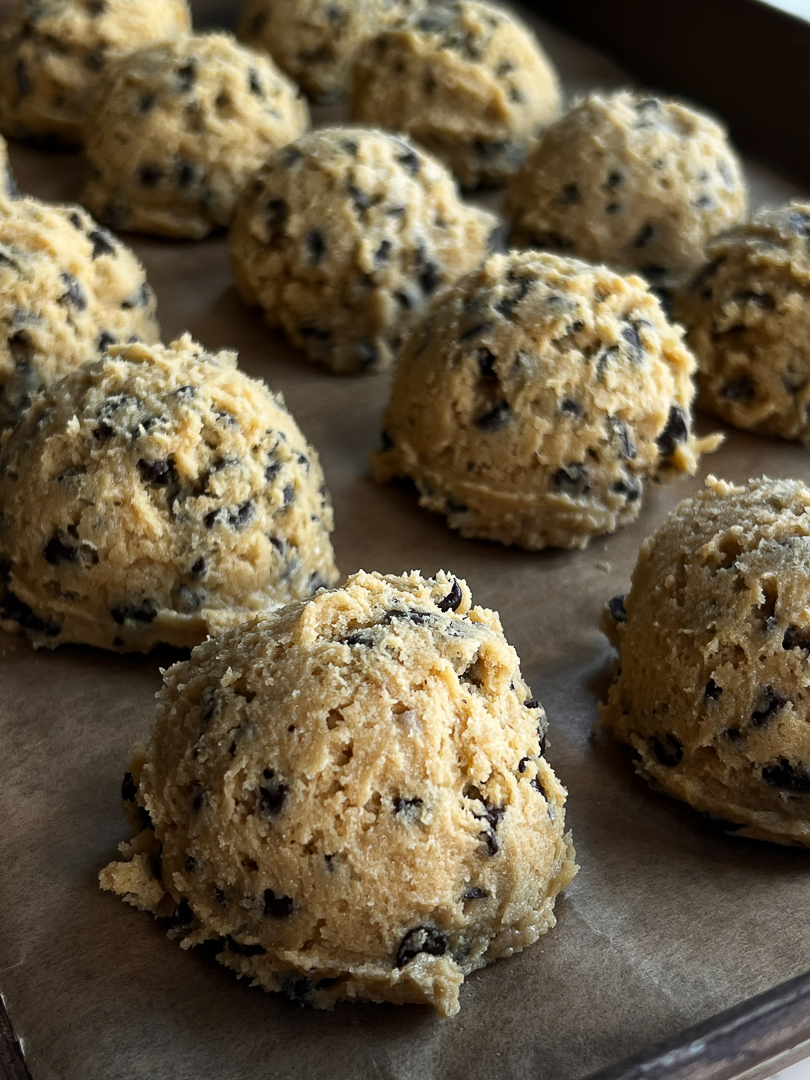The Ultimate Guide to Troubleshooting Chocolate Chip Cookie Problems

Is there anything better than biting into a perfectly baked chocolate chip cookie?
For many of us, cookies aren’t just a treat — they’re comfort and nostalgia. But even though they seem simple, baking the perfect chocolate chip cookie can be tricky.
👉 In this guide, you’ll learn how to troubleshoot common cookie problems and bake cookies with confidence — whether you love them chewy, crispy, or gooey.
→ Love mastering classic bakes?
Explore Mini Loaf Cakes Made Easy → a complete guide to perfecting mini loaf cakes for home baking or business success.
Home Bakers' Edition - CLICK HERE
Baking Business Edition - CLICK HERE

Chocolate Chip Cookie Dough
Why Do Chocolate Chip Cookies Go Wrong?
Even though chocolate chip cookies are considered an "easy" bake, technique matters hugely.
Small details in ingredient ratios, mixing, and temperature can make or break your cookies.
→ Want a tried-and-tested recipe?
Get my Tried-and-Tested Chocolate Chip Cookie Recipe Ebook - CLICK HERE→ my foolproof base for consistent results.
1. Excessive Spread in Cookies
The problem: Cookies spread too much → become thin, greasy, or one big blob.
Possible Causes & Fixes:
-
Overmixed Dough: Mix butter + sugar only until combined.
-
Unbalanced Sugar: Balance white & brown sugar for controlled spread.
-
Low Baking Temperature: Bake at higher temp → helps cookies set faster.
-
Warm Baking Sheets: Always use a cool baking sheet for each batch.
-
Incorrect Ratios: Weigh your ingredients for accuracy.
-
Skipping Chill Step: Always chill dough before baking → prevents excess spread.
2. Not Enough Spread
The problem: Cookies don’t spread enough → turn out dense or dry.
Possible Reasons & Solutions:
-
Too much flour in dough
-
Using bread flour (too high protein) → use all-purpose/plain flour
-
Not enough fat or sugar
-
Wrong sugar ratio → too little white sugar
3. Hard or Dry Cookies
The problem: Cookies are hard, not soft & chewy.
What to Check:
-
Flour Overload: Weigh carefully → too much flour = tough cookies.
-
Overmixing: Mix gently after adding flour → prevents gluten overdevelopment.
-
Low Baking Temp: Bake as per recipe → too low temps dry out cookies.
-
Insufficient Fat: Butter adds moisture → ensure correct quantity.

Chocolate Chip Cookies With Valrhona Chocolate Chunks
4. Cakey Textures Instead of Chewy
The problem: Cookies turn out cakey → not chewy.
Why It Happens:
-
Overmixing: Introduces too much air → cake-like texture.
-
Using Baking Powder: Use baking soda → helps cookies spread rather than fluff up.
-
Too Much Flour: Changes wet/dry balance → leads to cakey cookies.
5. Cookies Sticking to the Baking Sheet
The problem: Cookies stick → difficult to remove.
Tips to Prevent Sticking:
-
Always use parchment paper → prevents sticking completely.
6. Chocolate Disasters
The problem: Poor chocolate choice ruins flavour/texture.
How to Choose the Right Chocolate:
-
Use bake-stable chocolate chips → prevent melting too thin.
-
For rich flavour → use chocolate with 60%+ cocoa content.
→ Want more chocolate baking inspiration?
Try my Dubai Chocolate Mini Loaf Cake - CLICK HERE → a customer favourite bake.
How to Achieve the Perfect Chocolate Chip Cookie Every Time
Mastering chocolate chip cookies comes down to:
✅ Understanding ingredient function
✅ Using proper technique → not overmixing
✅ Chilling dough → always!
✅ Weighing ingredients → precision matters
→ Ready to bake perfect cookies every time?
Grab my Tried-and-Tested Chocolate Chip Cookie Recipe Ebook
→ Want to level up your baking skills beyond cookies?
Explore Mini Loaf Cakes Made Easy → my 3-step system for perfect sponges, buttercreams, and pro finishes.
Home Bakers' Edition - CLICK HERE
Baking Business Edition - CLICK HERE
Keep Improving Your Baking Skills → Recommended Next Steps
🎓 Join my Buttercream & Cake Masterclass → → learn how to create bakery-quality finishes & stack stable cakes.
🎁 Download my FREE Mini Loaf Cake Piping Guide → → perfect your piping & buttercream skills → ideal for cakes and cookies too!
📚 Explore the Ultimate Guide to Cake Fillings & Frostings → Just $25 → → 45+ professional recipes & tips → build your filling + frosting knowledge.
Read The Baking Standard
Editorial guidance for bakers and food founders who care about technique, ingredients, and long-term credibility.
Unsubscribe anytime.







